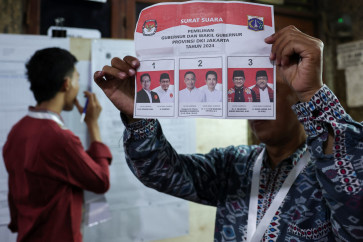Popular Reads
Top Results
Can't find what you're looking for?
View all search resultsPopular Reads
Top Results
Can't find what you're looking for?
View all search results21 provinces vulnerable to flooding until March: Agency
Heavy downpours and high waves were forecast for the country over the next three months, with 21 provinces named as the most prone to flooding, the Meteorology, Climatology and Geophysics Agency (BMKG) said Saturday
Change text size
Gift Premium Articles
to Anyone
H
eavy downpours and high waves were forecast for the country over the next three months, with 21 provinces named as the most prone to flooding, the Meteorology, Climatology and Geophysics Agency (BMKG) said Saturday.
The peak of the current rainy season was predicted to occur at the end of January, with expected rainfall of between 300 and 500 millimeters (mm), double the normal monthly rate of 150 millimeters.
The agency said heavy downpours were likely to cause flooding in several areas, including Jakarta, Riau, all Kalimantan provinces, North Sumatra, West Sumatra, Yogyakarta and Bali, among others.
Indonesia’s most forested province of Papua was also on the list of vulnerable regions.
“The high rainfall is [predicted] due to increasing sea temperatures at the end of January and early February,” BMKG head of climate change and water quality Edvin Aldrian told The Jakarta Post on Saturday.
The forecast was made by BMKG in coordination with the National Coordinating Agency for Land Survey and Mapping (Bakosurtanal) and the Public Works Ministry.
BMKG, however, forecast that extreme weather would not be as bad as last year, which saw heavy downpours prolonged into July. The prolonged 2010 rainy season has been blamed for causing harvest failure for chillies and other crops such as rice.
Under normal climate circumstances, July is usually Indonesia’s dry season, the agency said.
The agency estimated high sea temperatures would also affect wave heights across the country. “Sea waves could reach dangerous levels, above 5 meters in some areas, when all sea transportation is advised to stop operations,” Edvin said.
Wave heights in the Java Sea could average between 2 and 3.5 meters, he added.
President Susilo Bambang Yudhoyono has warned Cabinet ministers and local administrations to take action to reduce the impacts of extreme weather changes and the potential effects on the country’s food security.
The government has repeatedly announced that Indonesia was one of the countries most vulnerable to severe impacts caused by climate change.
Peoples’ Coalition for Fisheries Justice (Kiara) secretary-general Riza Damanik said that fishermen would be the most vulnerable to increasing wave heights as some 50 percent of the country’s 2.7 million fishermen may be unable to go to sea.
“We predict some 50 percent of fishermen would stop fishing if the waves remain high in coming months,” he said.
Riza blamed the government for delayed training to educate people to adapt to the extreme weather changes.
“The government has not prepared any concrete strategy to support adaptation measures for fishermen,” he said.
Adverse seas grounded thousands of fishermen along the coast of Lampung on Friday, with waves cresting between 1.5 and 3 meters high.
The BMKG issued a warning to all ferry operators in Kupang, East Nusa Tenggara, on Friday to stop services due to waves as high as 6 meters on Friday.
Edvin said the agency had posted a daily weather forecast and wave height predictions at their website, www.bmkg.go.id.
“But many remain unaware of the importance of weather predictions, including farmers,” he said, adding that the BMKG also submitted daily and weekly forecast to all government institutions.
The BMKG reported on its website that waves above 5 meters would hit the southern Indian Ocean hardest from of East Java to East Nusa Tenggara.
Wave heights of between 4 and 5 meters would also be expected in the southern Java Sea,
particularly in Central Java, but are also expected to stretch into East Nusa Tenggara.










